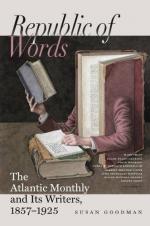Add that he is a man whose soul is in sympathy with the best thought, hope, and heart of the time. Brave, just, and humane, he is always on the right side, and always as direct and unflinching in the utterance of his faith as he is intrepid and right-natured in its adoption. Opinions are expressed in his work which do not accord with those of ecclesiastical majorities; nevertheless we think that those will thank him who least agree with him. It were, indeed, a shame that the people which sets the highest price upon political liberty should be the last to welcome the higher freedoms of thought; but it is a shame, we trust, which will not befall our country. We ourselves have, it is true, as little affection as most men for that sort of “free thinking” which consists in pouring out upon the public the mere wash and cerebral excretion of unclean spirits; but when any man has brought to a consideration of the greatest facts a pure and reverent spirit, he is entitled to present the results of his meditations with manly directness and vigor, as Mr. Alger has done in the work before us.
The “Complete Bibliography of the Subject” is an admirable piece of work. We present our respects to Mr. Ezra Abbot, Jr., and wish that many an earnest literary laborer had such a “friend.”
Dream Children. By the Author of “Seven Little People and their Friends.” Cambridge: Seaver & Francis.
The children seem to have found their Dickens at last. But, of course, it was to be expected that the child’s Dickens would be different, in some important respects, from the Dickens of grown-up men and women. And so he is. Children do with the world in their thoughts pretty much as they will; and the genuine artist, working for children, must recognize this, or he will utterly fail. The author of “Dream Children,” who made his introduction to the reading public as the author of “Seven Little People and their Friends,” has the rare faculty of realizing for himself the exact position and attitude of the child. This position he takes so earnestly that he has nowhere the air of assumption or arbitrary fiction. The child lives so much in pictures! But the pictures must not betray one single feature of unreality, or the whole effect is spoiled; a moral may be pointed or a tale adorned, but the child has lost his natural food. We need such works as that under present notice to keep children from starving,—works that are not mechanically adapted to children, but which come to them as their own fresh, pure thoughts come, bringing them pictures like those which their own untrammelled fancy paints for them.
We have no space to enter into any details here. The children must do that for themselves; but not the children alone. For, as now and then we come upon a piece of Art, a painting or a statue, which from its subject would seem to belong peculiarly to the child’s world, but which, because it is genuine Art, as to its manner and execution, rises out of this confinement to a single class, becoming universal, so it is with books of a similar character. This is true of the present work more emphatically than of the former work by the same author. The more external features of the work—its exquisite getting-up, in paper, binding, and especially in illustration—are only fitting to the inherent gracefulness of the writer’s thought.




